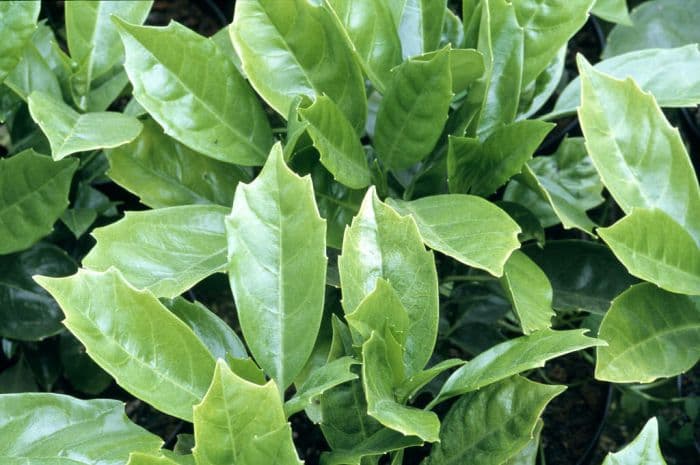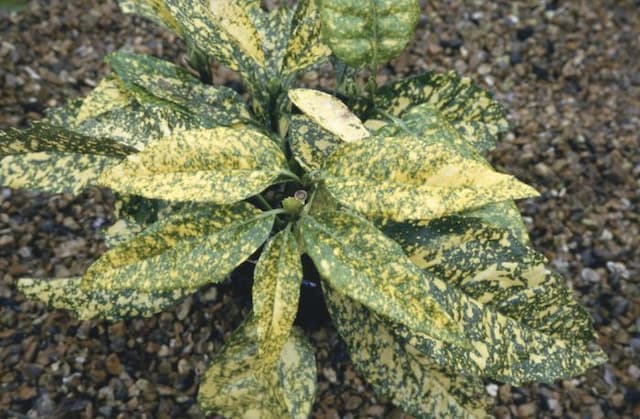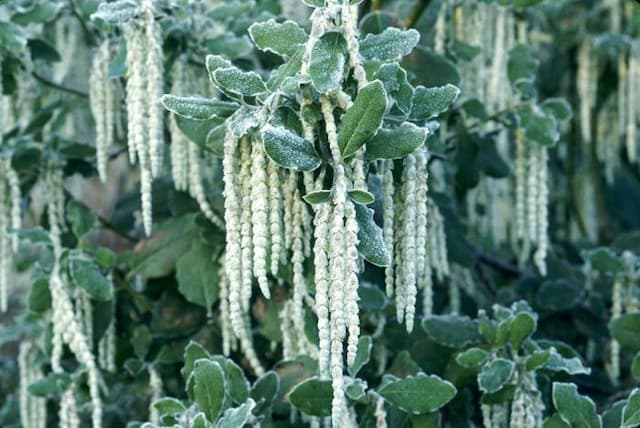Japanese laurel Aucuba japonica 'Rozannie' (f)

ABOUT
The Aucuba japonica 'Rozannie', commonly known as the Japanese laurel 'Rozannie', is an eye-catching evergreen shrub. It is well-noted for its glossy, leathery leaves which are a deep green in color. The foliage is quite dense, providing a rich, lustrous texture to the plant. Its leaves are uniquely speckled with yellow spots, creating a variegated appearance that adds visual interest to any garden space. Japanese laurel 'Rozannie' is also distinguished by its ability to produce attractive red berries, which can add a burst of color during the fall and winter months. These berries are particularly showy against the dark green backdrop of the leaves. The plant has a bushy, rounded form which contributes to its aesthetic appeal, making it a popular choice for both standalone and grouped plantings in landscaping designs. Flowering in the Japanese laurel 'Rozannie' is modest, with small, purple-maroon blooms that may appear in the springtime. These flowers are often overlooked due to their size and subtlety in comparison to the showy foliage and berries. The overall appearance of the Japanese laurel 'Rozannie' is one of robust health and vitality, making it a reliable and attractive addition to a variety of outdoor settings.
About this plant
 Names
NamesFamily
Garryaceae.
Synonyms
Japanese Aucuba, Spotted Laurel, Japanese Laurel, Gold Dust Plant, Variegated Aucuba.
Common names
Aucuba japonica 'Rozannie'.
 Toxicity
ToxicityTo humans
The plant commonly known as Japanese laurel is not considered highly toxic to humans. However, ingestion of its leaves or berries in significant amounts may potentially cause mild stomach upset with symptoms such as nausea or vomiting.
To pets
Japanese laurel can also be mildly toxic to pets if ingested. The symptoms of poisoning in animals may include vomiting, diarrhea, and abdominal pain. Pet owners should take care to prevent their animals from eating this plant to avoid potential discomfort and gastrointestinal issues.
 Characteristics
CharacteristicsLife cycle
Perennials
Foliage type
Evergreen
Color of leaves
Green
Height
3-4 feet (0.9-1.2 meters)
Spread
3-4 feet (0.9-1.2 meters)
Plant type
Shrub
Hardiness zones
7
Native area
Japan
Benefits
 General Benefits
General Benefits- Ornamental Appeal: Aucuba japonica 'Rozannie' offers year-round visual interest with its glossy green leaves and red berries, making it a popular choice for ornamental garden use.
- Low Maintenance: This plant is known for being hardy and requiring minimal care, making it suitable for gardeners of all skill levels.
- Shade Tolerance: 'Rozannie' thrives in shady conditions where other plants may struggle, providing gardeners with a beautiful option for dark corners of the garden.
- Drought Resistance: Once established, it can withstand periods of dryness, reducing the need for frequent watering.
- Dense Foliage: Its dense growth habit can provide privacy and can be used effectively as a hedge or screen in landscaping.
- Versatility in Landscaping: Suitable for a variety of landscape designs including borders, containers, and as a specimen plant.
- Wildlife Friendly: The berries of 'Rozannie' can attract birds and other wildlife to the garden, offering ecological benefits.
 Medical Properties
Medical PropertiesThis plant is not used for medical purposes.
 Air-purifying Qualities
Air-purifying QualitiesThis plant is not specifically known for air purifying qualities.
 Other Uses
Other Uses- Aucuba japonica 'Rozannie', commonly known as Spotted Laurel, can be used to craft floral arrangements due to its glossy green foliage which provides a lush backdrop for flowers.
- Spotted Laurel leaves are sometimes used in small scale model making or dioramas to represent larger tree foliage because of their size and texture, making them suitable for miniature landscapes.
- The plant's berries can be used as a natural dye, producing hues ranging from green to yellow, albeit this is not a common practice.
- Spotted Laurel can be used in topiary gardens because it responds well to pruning and can be shaped into various forms.
- The dense foliage of Spotted Laurel makes it an excellent choice for privacy hedges in gardens and landscapes where screening is desired.
- Its leaves can serve as a natural mulch when fallen, providing soil health benefits such as moisture retention and temperature regulation.
- Spotted Laurel can be featured in sensory gardens as its leaves have a distinct texture; providing a tactile experience for visitors.
- Due to its durability and resistance to pollution, Spotted Laurel is an apt choice for urban gardening in cities and areas with high vehicle emissions.
- Aside from horticultural appreciation, the plant can be used as a teaching tool for biology classes detailing leaf structures and variegation patterns.
- The contrast between the green leaves and red berries of the Spotted Laurel can be used in color theory studies and visual art projects.
Interesting Facts
 Feng Shui
Feng ShuiThe Japanese laurel is not used in Feng Shui practice.
 Zodiac Sign Compitability
Zodiac Sign CompitabilityThe Japanese laurel is not used in astrology practice.
 Plant Symbolism
Plant Symbolism- Resilience: Aucuba japonica 'Rozannie', commonly known as Japanese laurel or spotted laurel, is known for its hardiness and its ability to thrive in challenging conditions. It represents the ability to endure and persist.
- Protection: With its evergreen leaves, the Japanese laurel is seen as a symbol of protection, offering shelter and safety all year round.
- Clarity: The glossy shine of the leaves can symbolize clarity and the offering of a fresh perspective or insight.
- Good Fortune: In some cultural beliefs, the laurel is associated with good fortune and prosperity, possibly due to its gold-spotted leaves which can be reminiscent of coins.
 Water
WaterTo properly water the Japanese Laurel 'Rozannie', it is important to maintain consistent moisture in the soil, without letting it become waterlogged. During the growing season, water the plant with about 1 gallon every week, making sure the soil is well-drained. Adjust the frequency of watering during hot, dry periods by checking the soil moisture level and watering when the top inch feels dry. Cut back on watering during the winter months, allowing the soil to dry out slightly between waterings. Avoid getting water on the foliage to prevent fungal issues.
 Light
LightThe Japanese Laurel 'Rozannie' thrives in partial shade conditions making it a great choice for a spot that receives filtered sunlight or shade for part of the day. Direct sunlight should be limited as it can cause the leaves to scorch. A location that provides morning sun with afternoon shade or light dappled through surrounding trees would be ideal for this plant.
 Temperature
TemperatureJapanese Laurel 'Rozannie' prefers a temperate climate and will do best in temperatures ranging from 60°F to 75°F. It can tolerate minimum temperatures down to about 10°F but may suffer foliage damage when exposed to extreme cold. Ideally, keep it in an environment where the temperature does not fluctuate drastically to ensure steady growth.
 Pruning
PruningPruning the Japanese Laurel 'Rozannie' is generally done to shape the plant or to remove damaged or diseased foliage. This should be carried out in late winter or early spring before the onset of new growth. It's not necessary to prune every year; rather, prune as needed to maintain the size and shape of the plant. Always use clean, sharp tools to make precise cuts.
 Cleaning
CleaningAs needed
 Soil
SoilSpot Gold Dust plant in a well-draining, humus-rich potting mix with a pH of 6.0-6.5. Incorporate peat moss and perlite to enhance drainage and maintain moisture.
 Repotting
RepottingThe Spot Gold Dust plant should be repotted every 2-3 years or when it becomes root-bound to encourage healthy growth.
 Humidity & Misting
Humidity & MistingSpot Gold Dust plants prefer moderate to high humidity but can tolerate lower levels without significant harm.
 Suitable locations
Suitable locationsIndoor
Place Spot Gold Dust in bright, indirect light; keep soil evenly moist.
Outdoor
Part shade; shelter from harsh sun; well-draining soil; mulch to retain moisture.
Hardiness zone
7-10 USDA
 Life cycle
Life cycleAucuba japonica 'Rozannie', commonly known as Japanese aucuba or spotted laurel, begins its life as a seed that germinates in moist, well-drained soils, preferably in shaded environments. As a seedling, it slowly develops a robust root system and foliage over several weeks. As it matures into a young plant, it forms glossy, green leaves with a dense, bushy habit, often taking several years to reach its full size, which can be up to 6 feet tall and wide. Once mature, it produces small, maroon-purple flowers in the spring, although 'Rozannie' is a female clone and will only bear fruit if a male pollinator is nearby. Following pollination, it develops bright red berries that persist through winter, attracting birds and other wildlife. As a perennial shrub, Japanese aucuba can live for many years, with some specimens surviving for decades in optimal conditions, completing its life cycle upon eventually succumbing to age or environmental stressors.
 Propogation
PropogationPropogation time
Early spring
Aucuba japonica 'Rozannie', commonly known as the Japanese Laurel, is best propagated through semi-hardwood cuttings. This method is most successful when performed in late summer. To propagate, a cutting of about 4 to 6 inches (10 to 15 cm) is taken from a healthy, semi-hardwood stem, ensuring at least a couple of leaf nodes are present. The lower leaves are removed, and the cut end is dipped into rooting hormone to encourage root growth. The cutting is then planted in a pot filled with a well-draining soil mix, such as a blend of peat and perlite. The pot should be kept in a warm, humid environment, and the soil should be kept consistently moist but not saturated. Roots typically develop within 8 to 12 weeks, after which the new plant can be gradually acclimatized before being transplanted to its final location.







